Creative Border Planting Ideas for Stunning Landscapes

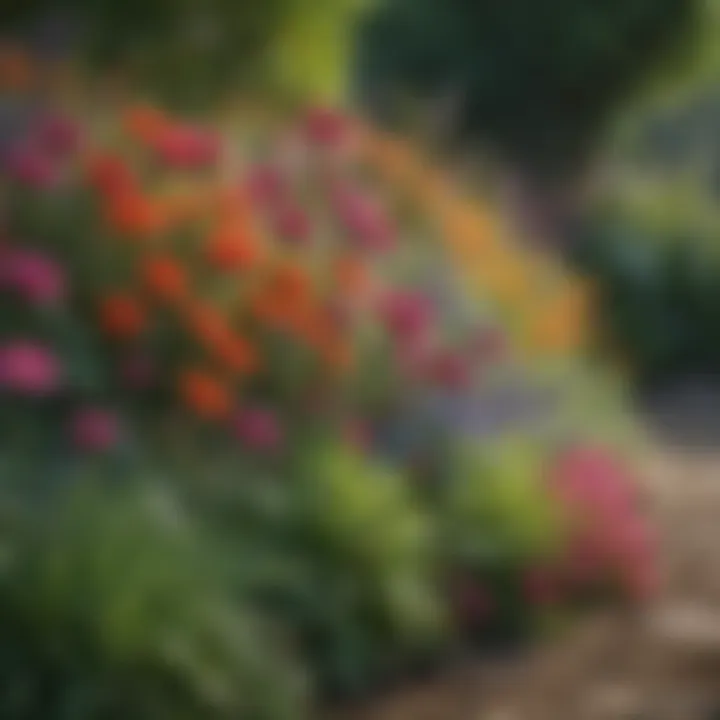
Intro
Border planting is a fundamental aspect of landscape design that can significantly enhance the overall aesthetics of any outdoor space. Whether you are tending a small urban garden or managing a sprawling lawn, the borders of your garden serve not just as boundaries but as opportunities for creativity and expression. The right plant choices, coupled with effective design techniques, can transform ordinary flower beds into visually striking elements that enrich the landscape. This guide aims to provide insightful ideas and practical strategies for various types of gardeners.
In exploring border planting ideas, we will cover essential elements such as color schemes, plant selections, and innovative gardening techniques. Each of these aspects contributes to a garden's aesthetic appeal and functionality. Understanding how to incorporate these ideas into your garden can empower both novice and experienced gardeners to cultivate stunning landscapes.
Design Inspiration
Current Trends in Garden Design
Presently, eco-friendly practices and native plant usage are gaining traction. A focus on sustainability not only helps promote local biodiversity but often requires less maintenance over time. Homeowners are increasingly leaning towards plants that adapt easily to their specific climates, reducing reliance on excessive watering and harmful fertilizers.
Color Schemes and Palette Ideas
The role of color in border planting cannot be overstated. Selecting the right hues can dramatically influence the mood and perception of your space. Here are some popular color trends:
- Monochromatic Schemes: Using various shades of a single color can create a unified and serene look. For instance, lighter and darker variants of blue can provide a calming effect.
- Complementary Colors: Combining opposing colors on the color wheel, such as purple and yellow, can create striking visual contrasts that stand out.
- Analogous Colors: Using colors that are next to each other on the wheel, like red, red-orange, and orange, promotes harmony.
Using these color palettes alongside thoughtfully selected plants will lead to dynamic, eye-catching borders.
"The borders of your garden are an invitation into your green space; they define not just the aesthetic but the atmosphere of the entire area."
Gardening Techniques
Plant Selection and Care
Choosing the right plants for your borders is essential. Factors to consider include climate, soil type, and sun exposure. Some popular choices include:
- Lavender: Drought-tolerant and aromatic, very appealing when placed in clusters.
- Hostas: Great for shady areas, offering lush greenery and beautiful blooms.
- Ornamental Grasses: Provide movement and texture while needing less water.
Once you select your plants, their care will determine the success of your border. Regular maintenance, such as watering, pruning, and fertilizing, is crucial to keeping your plants healthy.
Indoor vs. Outdoor Border Planting
While outdoor borders offer stunning visuals, indoor borders should not be overlooked. Indoor plants can provide attractive green accents and purify air, making them important for interior aesthetics. Using pots or planters to create defined lines indoors can help mimic the feel of outdoor borders. Successful indoor border plants include spider plants and peace lilies, which thrive in various light conditions.
In summary, effective border planting merges design inspiration with practical techniques. This combination will help you achieve a garden that is not only beautiful but also sustainable and functional.
Prologue to Border Planting
Border planting is an essential element of landscape design. It involves the strategic placement of plants along the edges of gardens, pathways, and outdoor areas. This practice not only enhances the beauty of the landscape but also provides structure and form to outdoor spaces. Borders can define areas, create a transition between different sections, and guide the viewer’s eye through the garden. Understanding border planting is vital for anyone looking to improve their landscape design.
One of the primary benefits of border planting is its ability to add depth and dimension to a garden. A well-planned border can create layers, making a flat area more visually appealing. In addition, borders serve functional purposes. They can act as natural barriers, define spaces, and even provide privacy.
Moreover, border planting encourages diversity in plant life, which can attract beneficial insects and wildlife. For homeowners and gardening enthusiasts, creating attractive borders is a straightforward way to elevate their outdoor aesthetics without overwhelming complexity.
Defining Border Planting
Border planting refers to the arrangement of plants along the edges of a garden or yard. This can include flowers, shrubs, or even vegetables, planted in a way that enhances the garden’s overall design. Borders can vary in size and style, from narrow beds along sidewalks to wide expanses that encircle entire garden areas. The intent behind border planting is rooted in aesthetics and functionality, influencing how spaces are perceived and used.
Most common border plants include perennial flowers like lavender, hostas, and sedum. Shrubs, such as boxwoods or hydrangeas, can also be effective in establishing visual boundaries. When done effectively, border planting can blend beauty and utility, allowing for dynamic outdoor spaces.
The Importance of Borders in Garden Design
Borders play a critical role in garden design by providing a framework for the entire layout. They help to establish the overall theme and structure of the garden while offering focal points for the viewer. Borders can direct movement and create lines that draw attention to specific areas.
From a practical standpoint, borders can also help prevent the encroachment of weeds into cultivated areas. They can serve to segment different functions within a garden, such as separating pathways from flower beds or distinct garden themes.
In organic gardening, borders can provide natural habitats for pollinators and beneficial insects, contributing to a healthier ecosystem. Overall, borders are not just decorative; they represent crucial components in designing a functional and aesthetically pleasing landscape.
Types of Border Planting
Understanding the types of border planting is crucial. Each category brings unique character and visual interest to spaces. By knowing these types, homeowners and garden enthusiasts can tailor their selections to match specific aesthetic desires or environmental needs. This thoughtful approach results in diverse, attractive gardens, enriching their properties.
Herbaceous Borders
Herbaceous borders consist primarily of flowering plants and perennial species. They are vibrant and can provide consistent blooms throughout multiple seasons. Such borders often thrive in sunny locations, with a variety of species that can reach different heights, enhancing the visual impact.
Herbaceous plants contribute significantly to pollinator health. Their blossoms attract bees, butterflies, and other beneficial insects. Additionally, they tend to require less maintenance once established, making them efficient for busy homeowners. Here are some essential features of herbaceous borders:
- Typically include perennials, annuals, and bulbs.
- Ideal for showcasing colors across seasons.
- Can create a lively contrast to evergreen structures.
Incorporating species such as Lavandula (lavender) or Echinacea (coneflower) not only ensures beauty but also bolsters local ecology.
Shrub Borders
Shrub borders are more structured than herbaceous ones. They predominantly consist of larger plants that provide a strong framework for the landscape. Shrubs can serve multiple purposes: offering privacy, defining spaces, and providing a backdrop for smaller plants.
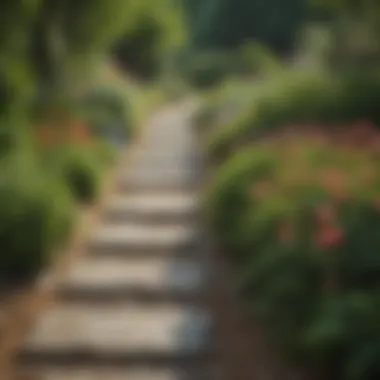

These borders are advantageous for seasonal interest. As many shrubs exhibit changes with the seasons, they can offer visual variety throughout the year. Features of shrub borders include:
- Striking foliage that adds texture and depth.
- Year-long presence, with many shrubs maintaining their leaves.
- Opportunities for creative layering, enhancing visual appeal.
Using shrubs like Hydrangea or Spiraea allows homeowners to enjoy both structure and seasonal blooms, which makes them a popular choice.
Mixed Borders
Mixed borders represent a blend of herbaceous plants and shrubs. They creatively combine the benefits of both categories, resulting in a rich tapestry of colors, textures, and heights. This diversity supports strong ecological benefits and creates an engaging landscape experience.
The layout can vary extensively, allowing for personal expression in plant choices. Homeowners appreciate the flexibility mixed borders provide. Key points of mixed borders include:
- Versatility in combining various species.
- Enhanced biodiversity and habitat for wildlife.
- A dynamic visual display that evolves with the seasons.
Plants such as Rudbeckia or Berberis can be effective in mixed borders, providing both visual volume and delightful color.
The choice of border type can greatly impact the overall beauty and function of a garden. Familiarity with herbaceous, shrub, and mixed borders can empower gardeners to make informed decisions, leading to a thriving and sustainable outdoor space.
Selecting Plants for Borders
When considering border planting, selecting the right plants is crucial for achieving the desired aesthetics and functionality in a garden. This section will explore the vital aspects of choosing plants for borders, emphasizing how this choice affects the overall landscape design. The right plants can create stunning visual impacts while also promoting a sustainable garden ecosystem.
Considerations for Climate and Soil
Understanding your local climate and soil condition is essential for successful border planting. Different plants have specific requirements regarding sunlight, temperature, and moisture.
- Soil Type: First, identify if your soil is sandy, clayey, or loamy. This will affect drainage and nutrient availability.
- pH Levels: The acidity or alkalinity of your soil can influence plant health. Conducting a soil test will reveal this.
- Climate Zones: Knowing your hardiness zone can help narrow down suitable plant options. Some plants thrive in cooler climates, while others prefer warmth.
By focusing on these factors, you ensure that the selected plants not only survive but also flourish in your borders, thus contributing to a healthier garden.
Choosing Native Plants
Opting for native plants is a significant strategy when selecting species for borders. Native plants are adapted to the local habitat, making them more resilient to pests and diseases. They typically require less water and care because they thrive in existing soil and climate conditions.
- Lower Maintenance: Because they are adapted to the environment, native plants usually need less watering and fertilizing.
- Biodiversity: Incorporating native species supports local wildlife, including pollinators such as bees and butterflies.
- Ecosystem Compatibility: Native plants integrate well into the ecosystem, providing support for local fauna and flora.
Incorporating native plants into your borders can enhance the ecosystem health of your garden while achieving a beautiful, cohesive look.
Combining Colors and Textures
An appealing border integrates various colors and textures to create depth and interest. When selecting plants, consider their foliage, flowers, and growth habits.
- Color Palettes: Choose plants with contrasting or complementary colors. This can enhance visual appeal throughout the seasons.
- Foliage Variety: Differentiating textures, such as using broad-leaved plants alongside fine-textured ones, adds depth and visual interest.
- Bloom Times: Mixing plants based on their blooming periods ensures the border remains colorful and lively across seasons.
By thoughtfully combining colors and textures, you can create an engaging border that captivates onlookers while staying aligned with your overall landscape design.
Design Principles for Effective Borders
Creating effective borders in a landscape is an essential aspect of garden design. This approach not only serves an aesthetic purpose but also enhances the functionality of outdoor spaces. Borders provide structure and can guide the eye through the garden. They can delineate areas, frame views, and add depth. When designed well, borders can be the revealers of nature's beauty, drawing attention to flowers and plants that otherwise may be overlooked.
Layering Plants for Depth
Layering is a fundamental design principle in border planting. This involves placing taller plants at the back of the border and gradually decreasing the height of plants towards the front. By doing this, each layer remains visible, promoting a fuller appearance while maximizing visual interest. This structure allows light to reach the lower plants, ensuring they flourish. It is key to ensure that spent flowers are also masked from sight, thus maintaining an organized look. In essence, layering creates a multi-dimensional border that captivates viewers.
Creating Visual Flow
Visual flow is vital in guiding attention throughout the garden. This can be achieved by strategically placing plants in a way that leads the eye from one point to another. Curved lines often help achieve a smoother transition across different areas. Consider using plants that contrast in height or color while ensuring they complement each other overall. For example, a border that echoes colors found elsewhere in the garden creates continuity. Visual flow makes the space inviting, encouraging exploration of the garden.
Incorporating Pathways and Borders
Pathways enhance the usability of garden borders while providing a clear route for movement. Pathways should be designed not just for function but also to add to the garden’s aesthetics. Utilizing materials such as gravel, brick, or stone can provide a solid visual presence that frames the planting. The space between the pathway and the border can be filled with ground covers or low plants. This method unifies the design, tying flora and functionality together seamlessly. A well-defined pathway can lead guests through the landscape, allowing them to appreciate the borders without trample on the plants.
A harmoniously designed border is not just about plants; it is about how those plants interact with broader landscape elements.
Sustainable Gardening Practices in Border Planting
Sustainable gardening practices are essential for creating borders that not only look good but also benefit the environment. This approach goes beyond aesthetics. It involves integrating techniques that foster ecological balance, conserve resources, and promote resilience in gardens.
Utilizing Perennials
Perennials are key in sustainable border planting. These plants live for more than two years, offering beauty and reducing the need for constant replanting. By choosing perennials, gardeners can create self-sustaining borders that thrive through the seasons. Common examples include Echinacea, Sedum, and Salvia. Planting perennials helps to stabilize soil and reduce erosion. As they grow, they form networks of roots that provide habitat for beneficial organisms. This not only enhances the health of the garden but also minimizes maintenance efforts.
Water Conservation Techniques
Water is a valuable resource in gardening. Implementing water conservation techniques ensures that it is used wisely. One effective method is to design borders that utilize local rainfall. Planting drought-resistant species like Lavender or Yucca can significantly cut down on water needs. Additionally, installing drip irrigation systems can target plant roots directly, reducing water waste. Another practical approach is mulching. A layer of organic mulch not only retains soil moisture but also suppresses weeds and fosters beneficial microbial activity. Together, these methods can save both water and money over time.
Encouraging Biodiversity
Biodiversity enriches garden ecosystems. A diverse selection of plants attracts a variety of wildlife, which can be beneficial for pest control and pollination. When designing borders, include a mix of flowering plants, grasses, and shrubs that bloom at different times throughout the year.
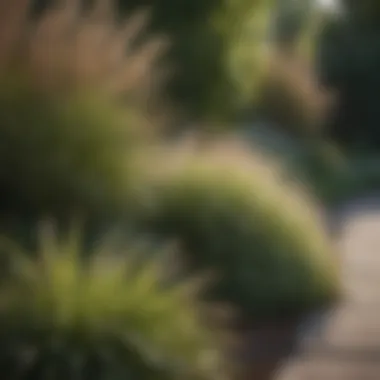
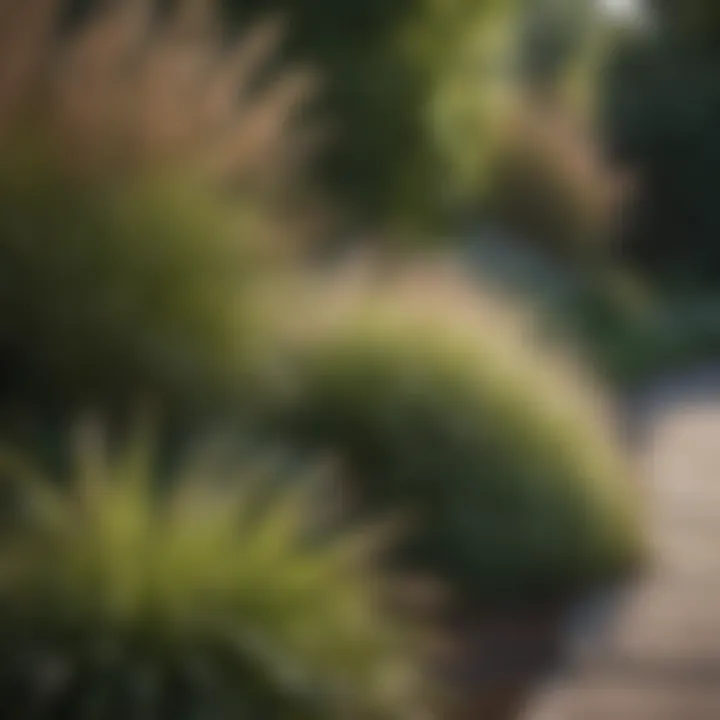
Including native species in your planting scheme is particularly beneficial. Native plants tend to have lower maintenance needs and are adapted to local soil and weather conditions. This makes them resilient and helps to maintain local ecosystems.
Moreover, varying the height, color, and texture of your plants can create a dynamic and visually appealing border that supports various life forms. This biodiversity can lead to healthier plant communities and reduced disease prevalence.
These practices not only create beautiful borders but also foster a sustainable gardening ethic that benefits the larger environment.
Seasonal Considerations for Border Planting
Understanding the seasons is fundamental when planning and maintaining border plantings. Each season brings different needs and opportunities for growth, affecting how plants respond in their environment. By considering seasonal factors, gardeners can maximize the health and aesthetics of their borders, ensuring they look their best year-round. The seasonal framework allows for effective planning in planting, upkeep, and preparation.
Spring Planting Strategies
Spring is often seen as the start of the gardening year. It is the perfect time to introduce new plants into your borders. Here are some strategies to consider:
- Soil Preparation: Begin with assessing soil health. Testing the pH level and nutrient content will inform necessary amendments. Adding compost can improve soil structure and fertility.
- Choosing the Right Plants: Focus on hardy plants that can establish roots quickly. Varieties like daffodils, tulips, and creeping phlox are excellent choices as they thrive in cooler temperatures.
- Timing: Ensure not to plant too early. Early frosts can damage young plants. Wait until the threat of frost has subsided.
These strategies help establish a solid foundation for border plants to flourish as the warmer months approach.
Summer Maintenance Tasks
Summer brings both beauty and challenges to garden borders. Regular maintenance is crucial to ensure your plants remain vibrant. The following tasks are essential:
- Watering: Consistent hydration is vital. Depending on the climate, borders may require deep watering twice a week. Be sure to water in the morning to minimize evaporation.
- Weeding: Keep borders free from competing weeds. Regular weeding not only helps aesthetics but also reduces competition for nutrients.
- Deadheading Flowers: Remove spent blooms from flowering plants. This promotes further blooming and prevents plants from going to seed too early.
These actions greatly enhance the productivity and overall appearance of border plantings.
Fall Preparation and Cleanup
As summer comes to a close, transitioning into fall is important for long-term plant health. Several preparatory actions will set the stage for a prosperous spring:
- Pruning: Trim back perennials and remove any dead or diseased foliage. This cleanup helps prevent pest issues in the future.
- Mulching: Applying a layer of mulch can protect roots from temperature fluctuations and conserve moisture during colder months.
- Planning for Next Year: As you clean up, take notes about what worked well and what didn't. This reflective practice can inform choices for the upcoming planting season.
Overall, a well-planned fall cleanup not only beautifies your borders but also fosters better growth down the line.
Common Mistakes in Border Planting
Understanding common mistakes in border planting is crucial. These pitfalls can hinder the beauty and functionality of your garden. By being aware of typical errors, you can avoid them and create a thriving landscape. This section discusses three significant mistakes often encountered in border planting: overcrowding plants, ignoring growth patterns, and neglecting maintenance.
Overcrowding Plants
Overcrowding occurs when plants are placed too close to each other. This can lead to several issues, including competition for nutrients, water, and sunlight. When plants are crammed together, some may fail to thrive. In extreme cases, overcrowding can result in diseases spreading more easily among plants, making your border less healthy overall.
To prevent overcrowding, consider the mature size of each plant. Check the recommended spacing on plant tags and plan accordingly. It is essential to visualize how plants will grow over time rather than how they appear when first planted. Incorporating some space can enhance air circulation and improve the aesthetic appeal of the border.
Ignoring Growth Patterns
Plants have different growth habits, which can significantly impact border design. Some plants grow tall and upright, while others spread out low to the ground. Failing to consider these growth patterns can lead to less-than-ideal arrangements. For example, placing tall plants in front of shorter ones obstructs their view, ultimately detracting from the overall look of your border.
It is helpful to group plants based on their size and habit. A layered effect creates visual interest and ensures that shorter plants receive adequate light. Researching each plant's characteristics can empower you to make informed decisions that contribute to a balanced and harmonious arrangement in your borders.
Neglecting Maintenance
Maintenance is essential to any garden, and borders are no exception. Neglecting regular care can result in overgrowth, invasive weeds, and diseases shutting down the vibrancy of your border. Without consistent attention, even the most well-planned borders can become unsightly and chaotic over time.
Set a maintenance schedule that includes tasks like pruning, weeding, and fertilizing. Regular deadheading and mulching can promote health and growth while keeping pests at bay. It may be helpful to keep a gardening journal to track your activities and results. By prioritizing maintenance, you can ensure that your border remains an attractive and healthy element of your landscape.
"Avoid common pitfalls in border planting by being conscious of plant spacing, growth habits, and maintenance needs. These practices lead to a beautiful and sustainable landscape."
Understanding these mistakes prepares you for successful border planting. Each element in your garden matters, from plant spacing to routine care.
Incorporating Hardscaping in Borders
Hardscaping plays a crucial role in the aesthetics and functionality of garden borders. It refers to the non-plant elements in landscaping, such as stones, bricks, and other construction materials. By strategically incorporating hardscaping elements, you can enhance visual appeal, create definition, and improve maintenance in your landscape. This, in turn, supports plant health by controlling erosion and water runoff.
When considering hardscaping for borders, there are several key elements to focus on:
- Edging: Defines the space between garden beds and pathways, adding structure.
- Paths: Creates accessibility, encouraging movement and exploration in your outdoor area.
- Decorative Features: Items like trellises and benches can enhance visual interest while providing functional space.
Integrating hardscaping thoughtfully can enhance the overall design of your garden, ensuring both beauty and practicality.
Using Edging Materials
Choosing the right edging material is essential for creating a polished look in border planting. Various options include stone, brick, wood, or metal. Each offers unique characteristics:
- Stone: Durable and weather-resistant, stone edging supports longevity in your design. You can choose natural stones like slate or granite for rustic appeal.
- Brick: Provides a classic look and can be arranged in numerous patterns, allowing for creativity.
- Wood: Offers warmth but may require more maintenance than stone or brick. Treated lumber or composite materials can last longer in outdoor conditions.
- Metal: Sleek and modern, options like corten steel create a minimalist look, suitable for contemporary gardens.
Selecting the right edging material can contribute significantly to your landscape’s design, emphasizing both form and function.
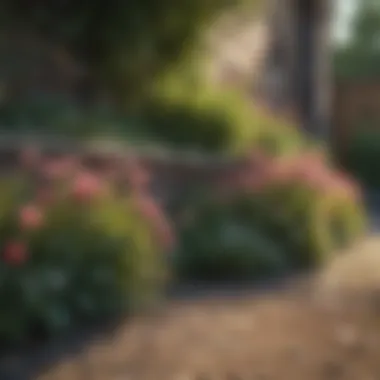

Integrating Decorative Features
Decorative features add personal touches to border plantings, enhancing the beauty and character of the space. Key elements include:
- Trellises: Ideal for climbing plants, they create vertical interest and can serve as a backdrop for softer plantings.
- Garden Statues: Adding a focal point, statues can help express your style and engage visitors.
- Lighting: Installing solar lights along borders can showcase your planting at dusk while adding a warm ambiance.
- Water Features: Small fountains or decorative ponds can introduce sound and movement, enriching the sensory experience of your garden.
By integrating decorative features thoughtfully, you can elevate your border planting, making your outdoor area more inviting and enjoyable.
Constructing Raised Borders
Raised borders are an excellent way to enhance plant health and aesthetic appeal in your garden. Here's why:
- Improved Drainage: Raised borders allow excess water to drain away, preventing root rot in plants.
- Ease of Maintenance: They provide easier access for weeding and harvesting, reducing strain on your back.
- Soil Quality: You can control the soil composition more effectively, providing ideal conditions for plant growth.
When constructing raised borders, consider:
- Materials: Use rot-resistant wood, stone, or even recycled materials like concrete blocks.
- Height: Raised beds should be high enough to ease bending and reach while providing sufficient root space for the plants.
- Layering: Include a mix of soil, compost, and mulch to provide optimal conditions for plant health.
In summary, incorporating hardscaping elements can significantly enhance the overall function and beauty of border plantings. Choosing the right materials and features ensures that your garden achieves desired aesthetic outcomes while remaining sustainable. For more detailed insights, consider visiting Wikipedia, Britannica, or Reddit for community discussions on gardening techniques.
Border Planting for Various Garden Styles
Border planting plays a vital role in enhancing the overall aesthetics and functionality of a garden. It creates defined spaces that can lead the eye through a landscape while providing structure and coherence to the garden design. Different garden styles require tailored approaches to border planting, allowing homeowners to integrate plants that reflect their personal style while enhancing the distinct character of the space. In this section, we will explore border planting ideas tailored to three specific styles: Cottage Gardens, Modern Minimalist Gardens, and Formal Gardens. Each style has unique elements and considerations that will provide insight into effective border planting techniques.
Cottage Gardens
Cottage gardens are characterized by their informal and densely packed plantings. These gardens often embrace a chaotic beauty, with a mix of flowers, herbs, and vegetables. Border planting in cottage gardens should enhance this spontaneity while ensuring a sense of harmony. The ideal borders incorporate a variety of plants with different heights, textures, and colors.
When selecting plants, consider:
- Perennials like Rudbeckia and Echinacea for long-lasting blooms.
- Climbing plants like Clematis for vertical growth.
- Herbs, such as lavender and thyme, that can add both visual appeal and functionality.
Using natural materials for edges, such as wooden logs or terracotta pots, aligns well with the cottage aesthetic. These simple details can accentuate the charm of your garden.
"Cottage gardens reflect a carefree spirit; border plantings capture that essence without losing focus."
Modern Minimalist Gardens
In contrast, modern minimalist gardens emphasize simplicity and clean lines. This style often relies on a limited plant palette and intentional placements to achieve a sense of calm. The primary goal of border planting here is to maintain the minimalist ethos while providing enough interest through textures and forms.
Choose plants that:
- Have structural qualities, such as ornamental grasses like Miscanthus.
- Use a monochromatic color scheme, perhaps focusing on greens and whites with plants like Helleborus or Ferns.
- Incorporate hard materials, like stone or gravel mulch, to further reduce visual clutter.
Keep borders clear and uncluttered, allowing the space to feel expansive and open.
Formal Gardens
Formal gardens are defined by their structured layouts and geometric designs. Border planting in formal gardens should reinforce the symmetry and formality of the space. The choice of plants should reflect this structured aesthetic while also providing continuity.
Consider using:
- Boxwood hedges for low borders that offer clear, defined edges.
- Annuals, like pansies or begonias, planted in organized patterns for seasonal interest.
- Statues or topiary as focal points integrated into the borders to maintain a formal theme.
Every detail counts in formal gardens. Borders must be well-maintained, ensuring that overgrowth does not disrupt the crisp lines that characterize this style.
By understanding the different styles and their respective requirements, homeowners can effectively utilize border planting to enhance the beauty and function of their gardens. This tailored approach leads to stunning visual outcomes while fostering an environment reflective of personal taste.
The End: Mastering Border Planting Techniques
In the world of landscape design, mastering border planting techniques is essential for creating visually appealing gardens. This conclusion encapsulates the critical elements of design choices and future trends discussed throughout this article. Border planting is not merely about aesthetics; it serves practical purposes. It can define spaces, promote biodiversity, and enhance the overall functionality of your garden.
Being deliberate about design choices is vital. Homeowners should consider their individual preferences and the specific characteristics of their outdoor spaces. Each plant selection contributes to the garden's story and reflects the gardener's personality. Good design balances form and function, ensuring that every border serves a purpose while remaining beautiful.
Just as important are the emerging trends in border planting. Sustainable practices, such as using native plants and promoting biodiversity, are gaining traction. Homeowners should embrace these trends while incorporating innovative design elements. This approach ensures a garden not only thrives but also stays relevant in a rapidly evolving landscape aesthetic.
"In its essence, border planting is a reflective practice—one that considers the past, embraces the present, and anticipates the future."
By mastering these techniques, you position yourself to create a garden that is both enchanting and sustainable. As you reflect on your design choices and stay informed about future trends, you contribute positively to the environment while enhancing your own living space.
Reflecting on Design Choices
Reflecting on design choices is imperative for the success of your border planting endeavors. Each decision made during the planning phase influences the overall harmony of the garden. Start by assessing your garden's unique conditions—this includes factors like sunlight, soil type, and climate. These considerations guide you in choosing the right plants for your project.
When selecting plants, think about their growth habits. Understanding whether a plant prefers full sun or partial shade affects how and where you position them within the borders. Additionally, consider color combinations and textural diversity. This adds depth and interest, making your borders more dynamic.
The significance of maintenance also cannot be ignored. Learning how to care for your chosen plants enhances their life span and vitality. Regular pruning, appropriate watering, and seasonal checks will prevent overcrowding and ensure that each plant thrives.
Future Trends in Border Planting
Looking ahead, border planting will likely evolve with a focus on sustainability and ecological awareness. As homeowners become more conscious of their environmental impact, there is a shift towards incorporating native species. These plants require less water and maintenance, making them ideal for today’s busy lifestyles.
Another upcoming trend is the use of technology in gardening. Smart irrigation systems and soil sensors can help optimize plant health while conserving resources. Additionally, we'll see more homeowners using creative hardscaping elements like decorative stones or recycled materials to frame their plant borders nicely.
The concept of edible landscapes is also gaining popularity. Integrating fruits, vegetables, and herbs within traditional flower borders not only serves aesthetic purposes but also enhances practical value.



